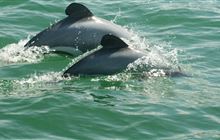Auckland’s coastal communities urged to report rare dolphin sightings
Archived content: This media release was accurate on the date of publication.
Introduction
People who live near or visit the west coast of the Auckland region are being urged to report sightings of the rare Māui dolphin.Date: 09 June 2021
DOC has a range of work underway to protect Māui dolphins. This subspecies of Hector’s dolphin is found only off the west coast of New Zealand’s North Island.
DOC Biodiversity Ranger Olivia Keane says the known Māui dolphin habitat extends from Taranaki to Northland’s Maunganui Bluff – a swathe of coastline which includes Auckland’s Manukau Harbour, where Māui dolphins have been occasionally seen.
“We’re still building our knowledge of this species, so public sightings reported to us are vital,” Ms Keane says.
Māui dolphins’ usual inshore distribution means the waters that are their home are the same waters that people use for fishing and recreation.
“Although only the hardiest people will be swimming as we head into winter, there are still a lot of people enjoying Auckland’s coastlines – surfers, boaties, beach-combers and people who go fishing.”
Classified as critically endangered, they are distinguishable from other dolphin species by their rounded dorsal fin which resembles an ear of the cartoon character Mickey Mouse.
“If you spot one of these identifiable dorsal fins, we want you to let us know.”
All sightings of Māui dolphins are valuable. The best way to report possible sightings of Māui dolphins is via the Hector’s and Māui Dolphins Sightings App, which can be downloaded from the Apple store and Google Play. App users can upload pictures of the dolphins they see, which helps with identification of the species.
It is suspected Māui dolphins may move further offshore during winter, something DOC staff hope to find more about through working with the non-profit organisation Māui63 and its large fixed-wing drone. The drone is equipped with high resolution cameras and artificial intelligence to detect the dolphins and will enable surveys of this rare subspecies in the winter months for the first time.
If people discover a Māui dolphin carcass on a beach, they can also help with research on the species, Ms Keane says.
“Encountering a Māui dolphin on the shore will be grim, but we can glean a lot of information from a dead animal – potentially its cause of death and any illnesses it had. We can respond quickly if people alert us by calling 0800 DOC HOT (0800 362 468) and sharing that information.”
During the summer and early autumn, DOC completed an abundance survey on Māui dolphins – the first since 2016. The results of the survey are expected later this year.
Editor’s note: Hector’s and Māui Dolphins Sightings App, can be downloaded from the Apple store and Google Play. 0800 DOC HOT (0800 362 468) is DOC’s hotline for people who need to report wildlife emergencies, illegal activity, disturbed marine mammals, removal of plants from reserves, vandalism of huts and tracks – and the discovery of any Māui dolphin carcasses.
Background information:
There are estimated to be less than 100 Māui dolphins. They are the smallest dolphins in the world, with females – the larger gender of the species – growing to about 1.7m long and weighing about 50kgs.
Compared to most dolphins, they have a short lifespan of about 20 to 30 years.
Māui dolphins are slow breeders, with female adults producing only one calf every two to four years. This means increasing the species’ population is very slow.
The Government has banned set netting in the dolphins’ habitat, and also introduced more stringent controls over petroleum and mineral industry activities in areas where they are found.
Contact
For media enquiries contact:
Email: media@doc.govt.nz

